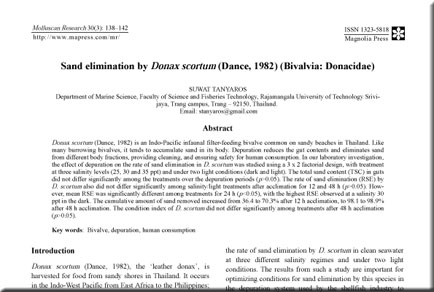Abstract
Donax scortum (Dance, 1982) is an Indo-Pacific infaunal filter-feeding bivalve common on sandy beaches in Thailand. Like many burrowing bivalves, it tends to accumulate sand in its body. Depuration reduces the gut contents and eliminates sand from different body fractions, providing cleaning, and ensuring safety for human consumption. In our laboratory investigation, the effect of depuration on the rate of sand elimination in D. scortum was studied using a 3 x 2 factorial design, with treatment at three salinity levels (25, 30 and 35 ppt) and under two light conditions (dark and light). The total sand content (TSC) in guts did not differ significantly among the treatments over the depuration periods (p>0.05). The rate of sand elimination (RSE) by D. scortum also did not differ significantly among salinity/light treatments after acclimation for 12 and 48 h (p>0.05). How-ever, mean RSE was significantly different among treatments for 24 h (p<0.05), with the highest RSE observed at a salinity 30 ppt in the dark. The cumulative amount of sand removed increased from 36.4 to 70.3% after 12 h acclimation, to 98.1 to 98.9% after 48 h acclimation. The condition index of D. scortum did not differ significantly among treatments after 48 h acclimation (p>0.05).

